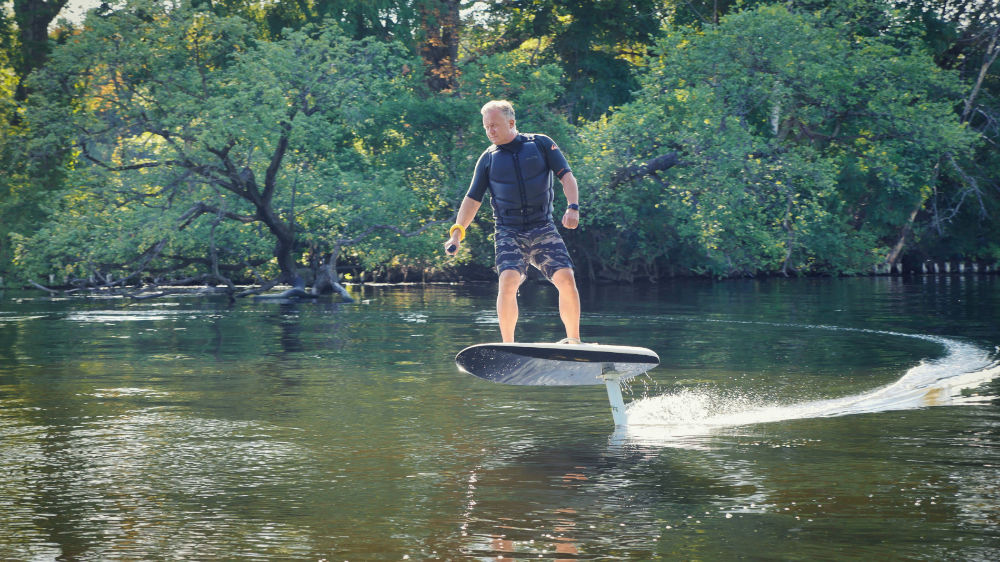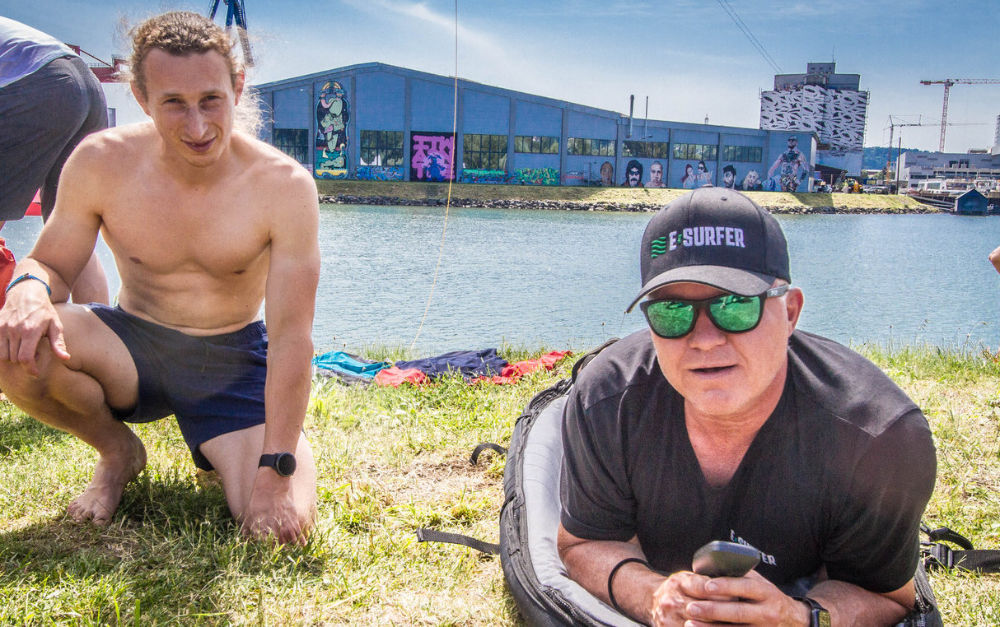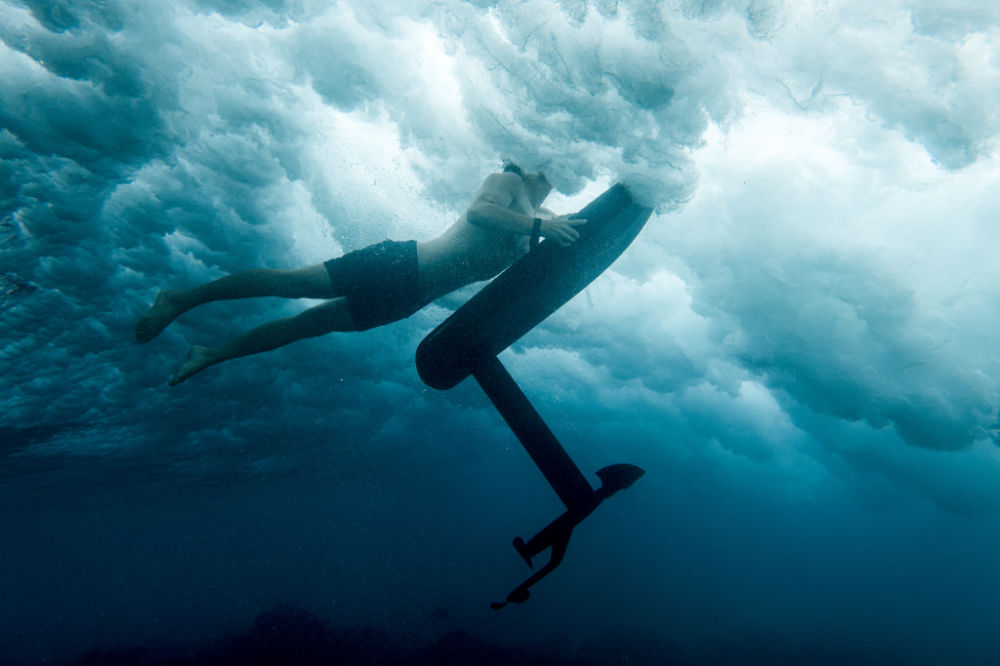
Anyone who wants to buy an eFoil will notice pretty quickly that the selection is getting larger and larger and confusing. In the eFoil comparison tables below, I have listed and compared all eFoils since 2017.
Please note: Our useful guides on electric surfboards, such as eFoils, jetboards, motorized bodyboards, and eFoil scooters, are now available in additional languages:
Both current models in the first eFoil comparison table and older versions that are no longer available in the second table. Of course, the eFoil comparison tables are updated regularly. You can also find product demonstrations of the different eFoils on the E-Surfer Youtube channel and our choices in the eFoil Shop.

Hardly a quarter goes by without a new eFoil being introduced on the web. Many of these announcements do not even make it to the market launch. The market potential is simply explored with such eFoil ideas.
It usually takes two years from a working prototype to a mature production product. Therefore, I would be cautious with newcomers, even if they usually advertise attractive prices.
Since the number of new announcements is increasing, while the number of products that actually make it to market is decreasing, we no longer include every new product in the eFoil comparison table. Rather, we focus on eFoils that are either already available for purchase or that we are sure will be available soon.
But even with these models, the number of manufacturers and especially the number of configurations has increased so much that we have created an eFoil buying guide here in addition to the comparison tables.
Ideally, you should visit our headquarters in Berlin or one of our branches and try out the boards. We offer eFoil training courses for this purpose. If this is not possible, we will be happy to advise you by phone. A good start is also this online eFoil buying guide for a first eFoil comparison.
We ask our customers the following questions to find the right eFoil:
A) One person or a small group with similar weight and skill level.
B) A group of people with different weights and different skill levels.
For answer A), we will try to find the sportiest setup for that person. Since such a board may be too difficult to learn on, we will have the customer ride a larger board first as part of our training until they master it. For people who are eligible for sportier boards, this usually happens quickly. Often under 30 minutes. After that, we switch boards and see how far they really get. Why do we do it this way? Simple. You don't buy a board for the first three hours, you want to enjoy it for a long time.

For answer B), we address the heaviest rider in the group. It must fit for him so that he can ride. This then allows everyone else in the group to ride. This does not necessarily mean that a bigger board is boring for lighter riders.
When riding eFoil, the following applies: When launching, 80 percent of it depends on the board. It must have enough volume to get even the heaviest rider in the group to glide. This ensures enough stability to kneel down and then stand up. When flying, on the other hand, 80% of what matters is the wing. After all, when you're floating, you're surfing on the wing and not on the board. After all, the board is in the air. While it's true that a taller and longer board offers a little more swing rate and thus doesn't turn as agile as a shorter board, 80% is the wing.
What does this mean? This means that you have to put more effort into launching with a shorter board, but you get less riding fun back in the end! So depends on the weight and skill of the heaviest rider which board to choose.
Here, as mentioned, we are talking about the heaviest rider in the group. In the eFoil comparison tables below we have specified the volume. A board should have no more than 10 liters less volume than the weight of the rider in kilograms. Don't forget the weight of the wetsuit, vest and helmet. Here are a couple of examples:
Of course, it also depends on the talent of the rider. Sporty riders can ride smaller boards. But the question is, how much work do you want to put in when launching? I usually take one size bigger than I can ride. Because I am too lazy ;-)

Although I personally can drive, for example, with 90 kg the radical Fliteboard Ultra and Lift Foils Pro, but still opt for a size larger. But that is a matter of taste.
There is a difference between eFoiling on a calm lake and in the ocean waves. The area has an influence on the size of the board, the wings and above all in the decision whether one should choose a propeller or jet drive. But more on this later.
Every board size (except the most radical models) comes with a standard wing. This wing setup has been matched exactly to the board by the manufacturer. Therefore, I can only advise everyone to start with this wing. Later on you can experiment with other wing variations to adjust the handling.
I would only exclude the most radical variants of the eFoils from this rule. While there is a manufacturer's recommendation here as well, riders of these boards usually know what they are doing. So who would I be to interfere ;-)
To begin with, manufacturers usually include a surf or cruiser wing. These all-rounder wings are suitable for most riders. Later there are Race wings for speeding or High Aspect wings that increase efficiency. One principle applies to all wings: the smaller, the faster and more maneuverable, but also harder to ride.
The first eFoil with jet drive was not available until 2022 with the Audi e-tron foil. In the meantime, I also rode other jet models. Among them was the Awake Vinga, the Jetfoiler, a Takuma and others.
While these jetfoils don't all ride the same, they all differ in similar ways from an eFoil with a propeller. First, of course, is the issue of safety. This is where the Jetfoils score in the eFoil comparison. Admittedly, accidents with propellers are very rare and almost always inattention - often on land - is involved or the risk of injury increased due to poor training. Still, no one wants to come into contact with the propeller in a big way.
With a jet propulsion system with a fully shielded impeller, this risk does not even exist.
In addition to safety, however, the riding behavior is also different. Whether to the advantage or disadvantage is a matter of taste and therefore you can test ride both variants at our shop. The point is this: A propeller generates more thrust than a jet drive. But what does that mean?
Due to the higher thrust of the propeller, the speed remains constant while surfing on the water surface and after take-off. So you don't have to readjust. With the Jetfoil, the board accelerates after takeoff, because much less power is needed during flight. Whether you like this or not is again a matter of taste. One likes the kick of the acceleration, the other prefers the constant speed. I like the kick ;-)
But the higher thrust of the propeller has another effect: on the sensitivity of the trigger of the remote control. Not only does the propeller create more pressure, it also creates more water resistance when decelerating. While a jetfoil accelerates and decelerates more smoothly, with a prop you have to have a good feel for the trigger. Both have advantages and disadvantages. Besides the typical "matter of taste", the prop is better suited for radical maneuvers because the thrust is there faster.
On the other hand, the jet is easier to ride and you don't need special accessories like folding propellers or TruGlide propellers to surf waves behind the boat or in the ocean. More details in our article "Jetfoil in the waves".
You already notice: a lot of matter of taste in our eFoil comparison ;-) Therefore come by and try it out. If not possible, we will find the right thing on the phone.

I don't want to list the black sheep here, but an eFoil should not always be "armed" when it is switched on. It is too easy to accidentally touch the trigger, whether on land or in the water. Premium manufacturers like Audi and Flite always have the board locked and it must first be unlocked by a button combination on the remote. You should pay attention to this.
Some boards also detect the angle of the board and won't let the propeller turn unless the board is level with the water surface. A good feature for eFoils with propeller.
I do not recommend a leash with a magnet kill switch. For jetboards this is in my opinion mandatory, because otherwise the jetboard can still go too far without a rider. But not with the eFoil. The eFoil can not go on without a rider. It crashes. In addition, the motors switch off as soon as the remote control falls into the water. A leash, however, would not only be a nuisance on an eFoil, but could also get caught in the mast or wing.
However, as always, there is one exception. If you should eFoil in conditions where the board can drift away, for example in current or strong wind, then you should secure the board with a leash. However, not with a magnetic kill switch, but firmly on the board. In these conditions, only very experienced eFoilers should ride anyway.
Efoils require far less power than jetboards. Most premium eFoils are around 5 kW and this has been proven to work. This is even enough for speeds up to over 50 km/h in flight. But on the one hand you need special race wings for such speeds and on the other hand I think this is not useful and also dangerous. But everyone must decide that for himself.
I, on the other hand, have no problem to ride a jetboard at 60 km/h. If I fall (of course with helmet and impact vest), then I flit here like a stone over the flat water. With the eFoil, on the other hand, I'm up to 80 cm above the water and tend to get stuck. In the worst case, the eFoil even starts to rotate in the air. Not my thing.
eFoiling is like snowboarding in powder snow. The ideal cruising speed is between 25 and 35 km/h. Jetboarding, on the other hand, is more like downhill ski ;-) Read more in our article "Jetboard or eFoil"?
While with jetboards the small batteries are usually only offered to achieve a lower price point, it makes perfect sense with the eFoil: namely to save weight. However, only for very good riders with very small board. Especially if they want to ride waves.
For the average consumer, the same applies as for the jetboard: in any case, the larger battery. No rule without exception: With the Awake Vinga, the 22 kg Jetboard battery can also be used. A normal sized eFoil battery is 13 kg for the premium manufacturers. So with the Vinga, please use the small battery.
Besides this eFoil comparison, we also have a battery comparison.
Now this is really a matter of taste, isn't it? Yes, but not entirely. I advise against black boards in any case. For Jetboards and for eFoils. Black boards simply heat up much faster in the sun, this heat goes straight into the electronics and this is counterproductive and can lead to overheating. If then only with very small boards, because here except the rubber pad is anyway no longer much of the board to see.
Although the rubber pads are also often black, but the rubber transfers the heat much slower than the board itself. Still, I would always put a board in the shade or cover it with a light-colored towel.
Therefore, there are only a few black boards in our store. I would rather call the Audi a dark gray. But we also sort out other colors or models if the color or material seems too sensitive.
Now finally the eFoil comparison tables with the most important data of the eFoils. I deleted the column with the prices at some point, because the amount of work became too big but also confusing. More about this below. But via the column "More info" you will get to the price ;-)
We took out the pricing information as it was misleading. Most prices on manufacturers websites are without VAT, shipping and import fees. Depending on where you live and where you order this could easily add a few thousand EUR. You can however find the prices in the linked articles. Our own eFoil shop shows prices incl. 19% VAT for Germany.
The next eFoil comparison table shows electric foil-boards which are not available anymore:

There is a reason why top players such like Audi and Fliteboard who developed their products over 3 or more years charge about 9,000 to 24,000 EUR including VAT and shipping and we find it hard to believe that some newcomers can just deliver the same quality for half of the price. As mentioned above we are especially concerned about cheap batteries which represent 30-40% of the price. Of course 15k EUR is not a small investment, but you should compare the value with a Jet-Ski / Personal Watercraft rather than with a “surfboard with motor”. There is quite a few technology involved.
If you go for a cheap eFoil from China ( a lot of the re-branded locally in Europe or the US) with no local support it will probably get more expensive for you. This is because you will potentially lose a few thousand EUR for nothing. We don’t want to be negative, but we want to be realistic.
If you have feedback or questions about this eFoil comparison, please visit our forum.